Jackson M.J. Micro and Nanomanufacturing
Подождите немного. Документ загружается.

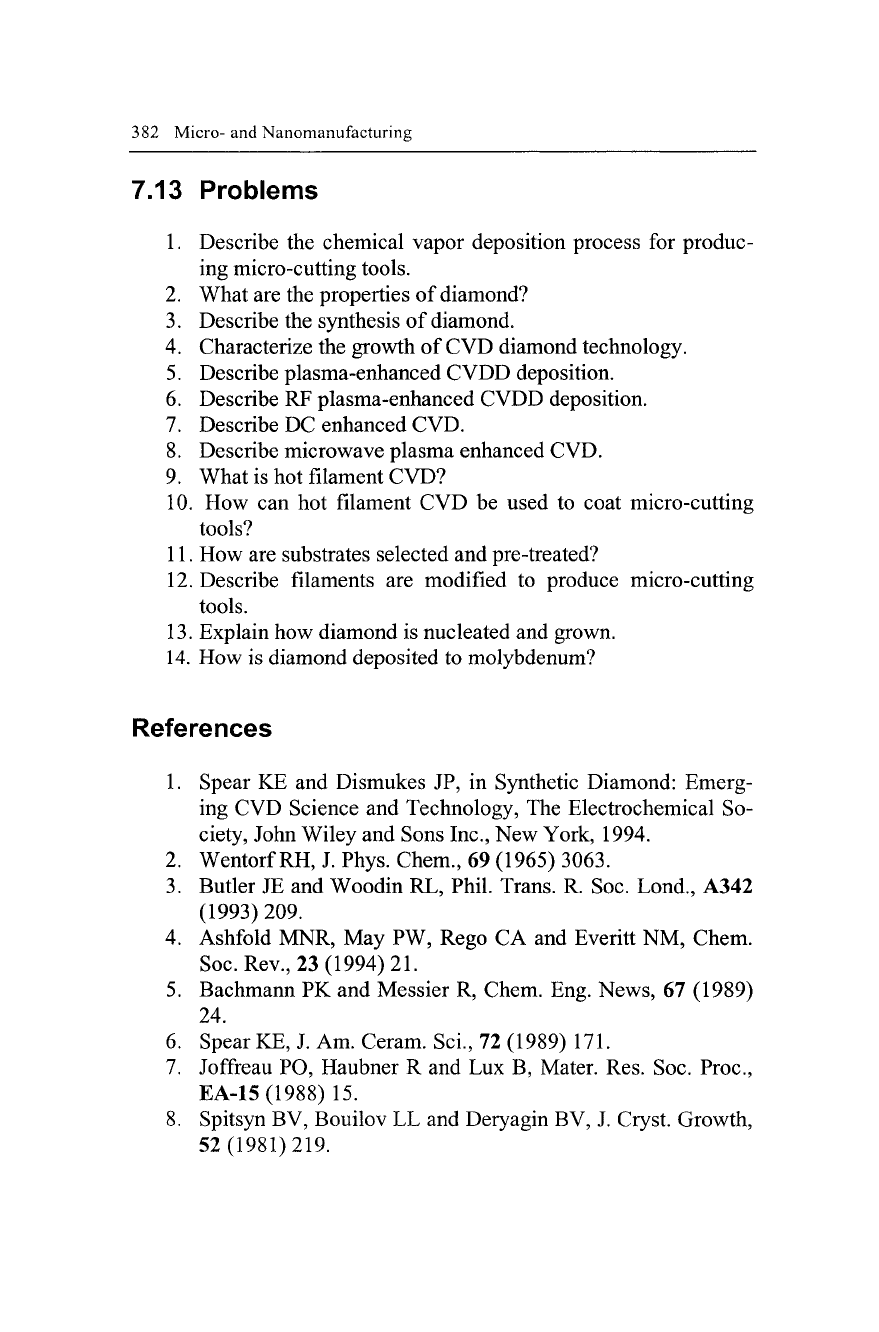
382 Micro- and Nanomanufacturing
7.13 Problems
1.
Describe the chemical vapor deposition process for produc-
ing micro-cutting tools.
2.
What are the properties of diamond?
3.
Describe the synthesis of diamond.
4.
Characterize the growth of CVD diamond technology.
5.
Describe plasma-enhanced CVDD deposition.
6. Describe RF plasma-enhanced CVDD deposition.
7.
Describe DC enhanced CVD.
8. Describe microwave plasma enhanced CVD.
9. What is hot filament CVD?
10.
How can hot filament CVD be used to coat micro-cutting
tools?
11.
How are substrates selected and pre-treated?
12.
Describe filaments are modified to produce micro-cutting
tools.
13.
Explain how diamond is nucleated and grown.
14.
How is diamond deposited to molybdenum?
References
1.
Spear KE and Dismukes JP, in Synthetic Diamond: Emerg-
ing CVD Science and Technology, The Electrochemical So-
ciety, John Wiley and Sons Inc., New York, 1994.
2.
Wentorf
RH,
J. Phys. Chem., 69 (1965)
3063.
3.
Butler JE and Woodin RL, Phil. Trans. R. Soc. Lond., A342
(1993) 209.
4.
Ashfold MNR, May PW, Rego CA and Everitt NM, Chem.
Soc.
Rev., 23 (1994) 21.
5.
Bachmann PK and Messier R, Chem. Eng. News, 67 (1989)
24.
6. Spear KE, J. Am. Ceram. Sci., 72 (1989) 171.
7.
Joffreau PO, Haubner R and Lux B, Mater. Res. Soc. Proc,
EA-15(1988) 15.
8. Spitsyn BV, Bouilov LL and Deryagin BV, J. Cryst. Growth,
52(1981)219.

Diamond Microcutting Tools
383
9. Angus
JC,
Electrochem. Soc. Proc,
89
(1989)
1
10.
Yarbrough
WA and
Messier
R,
Science,
247
(1996)
688.
11.
Messier
R,
Badzian
AR,
Badzian
T,
Spear
KE,
Bachmann
PK
and Roy R,
Thin Solid Films,
153
(1987)
1.
12.
Angus
JC and
Hayman CC, Science, 241 (1988)
913.
13.
Spear KE,
Am J,
Ceram.
Soc, 72
(1989)
171.
14.
Kamo
M,
Sato
U,
Matsumoto
S and
Setaka
N,
Cryst
J.
Growth,
62
(1983)
642.
15.
Saito
Y,
Matsuda
S and
Nagita
S,
Mater
J. Sci.
Lett.,
5
(1986)
565.
16.
Saito
Y,
Sato
K,
Tanaka
H and
Miyadera
H,
Mater
J. Sci., 24
(1989)293.
17.
Williams
BE,
Glass
JT,
Davis
RF,
Kobashi
K and
Horiuchi
T,
Vac J
Sci. Technol.
A,
Vac.
Surf.
Films,
6
(1988)
1819.
18.
Kobashi
K,
Nishimura
K,
Kawate
Y and
Horiuchi
T, Vac J
Sci.
Technol.
A,
Vac.
Surf.
Films,
6
(1988)
1816.
19.
Liou
Y,
Inspector
A,
Weimer
R and
Messier
R,
Appl. Phys.
Lett.,
55
(1989) 631.
20.
Zhu W,
Randale
CA,
Badzian
AR and
Messier
R, Vac J. Sci.
Technol.
A,
Vac. Surface Films,
7
(1989)
2315.
21.
Matsumoto
S,
Mater
J. Sci.
Lett.,
4
(1985)
600.
22.
Matsumoto
S,
Hino
M and
Kobayashi
T,
Appl. Phys. Lett.,
51(1987)737
23.
Vitkayage
DJ,
Rudder
RA,
Fountain
GG and
Markunas
RJ,
Vac
J. Sci.
Technol,
A6
(1988)
1812.
24.
Meyer
DE,
lanno
NJ,
Woolam
JA,
Swartzlander
AB and
Nelson AJ, Mater J. Res.,
3
(1988)
1397.
25.
Wood
P,
Wydeyen
T and
Tsuji
O, in
Programs
and
Abstracts
of the First International Conference
on New
Diamond Sci-
ence
and
Technology,
New
Diamond Forum, Tokyo, Japan,
1988.
26.
Jackman RB, Beckman
J and
Foord JS, Appl. Phys. Lett.,
66
(1995)1018.
27.
Suzuki
K,
Sawabe
A,
Yasuda
H and
Inuzuka
T,
Appl. Phys.
Lett,
50
(1987)
728.
28.
Akatsuka
F,
Hirose
Y and
Kamaki
K, Jap. J.
Appl. Phys.,
27
(1988)L1600.
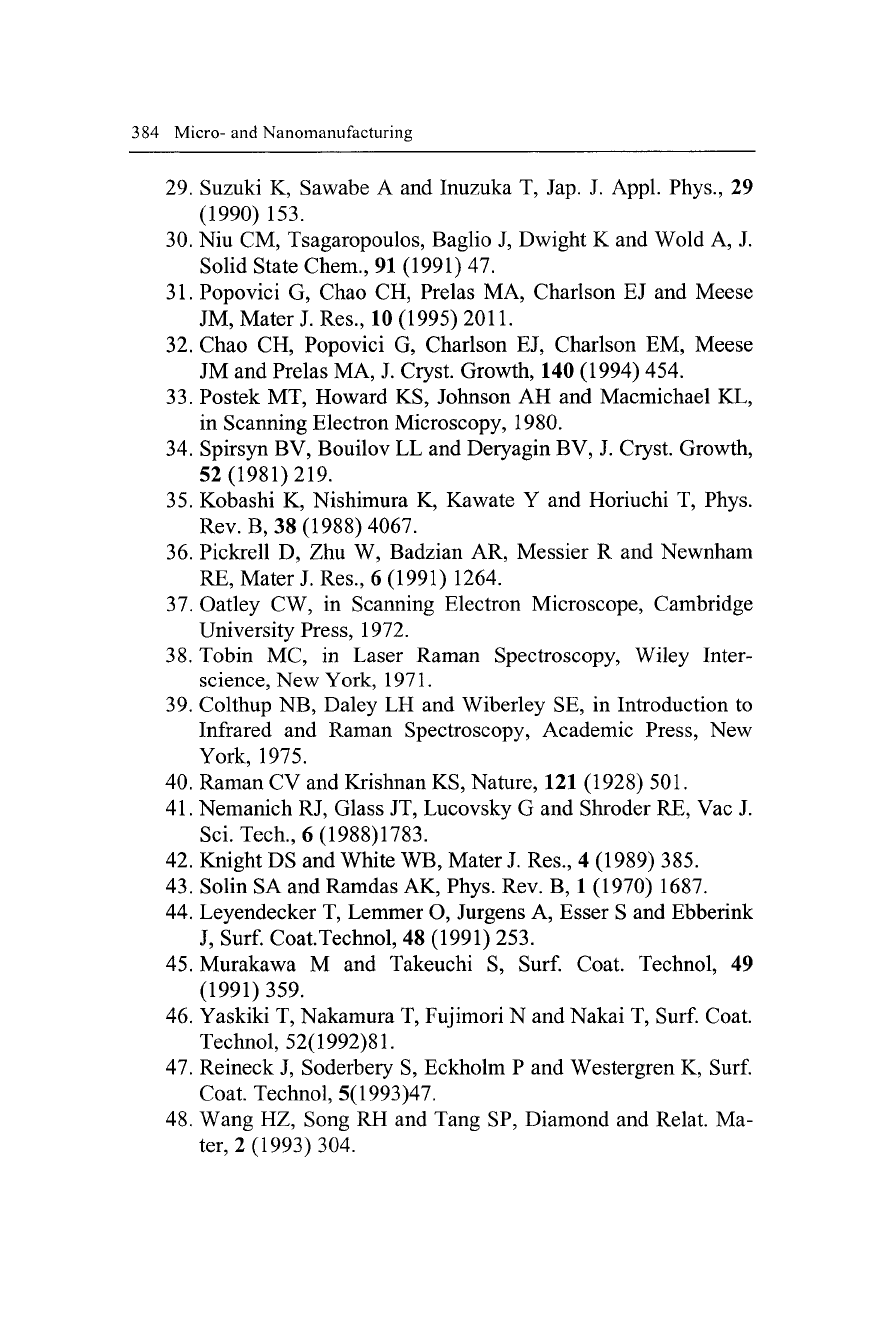
384 Micro-and Nanomanufacturing
29.
Suzuki
K,
Sawabe
A and
Inuzuka
T, Jap. J.
Appl. Phys.,
29
(1990)
153.
30.
Niu CM,
Tsagaropoulos, Baglio
J,
Dwight
K and
Wold
A, J.
Solid State Chem.,
91
(1991)
47.
31.
Popovici
G,
Chao
CH,
Prelas
MA,
Charlson
EJ and
Meese
JM,
Mater
J. Res., 10
(1995) 2011.
32.
Chao
CH,
Popovici
G,
Charlson
EJ,
Charlson
EM,
Meese
JM
and
Prelas MA,
J.
Cryst. Growth,
140
(1994)
454.
33.
Postek
MT,
Howard
KS,
Johnson
AH and
Macmichael
KL,
in Scanning Electron Microscopy,
1980.
34.
Spirsyn BV, Bouilov
LL and
Deryagin BV,
J.
Cryst. Growth,
52(1981)219.
35.
Kobashi
K,
Nishimura
K,
Kawate
Y and
Horiuchi
T,
Phys.
Rev.
B, 38
(1988) 4067.
36.
Pickrell
D, Zhu W,
Badzian
AR,
Messier
R and
Newnham
RE,
Mater
J.
Res.,
6
(1991)
1264.
37.
Oatley
CW, in
Scanning Electron Microscope, Cambridge
University Press,
1972.
38.
Tobin
MC, in
Laser Raman Spectroscopy, Wiley Inter-
science,
New
York,
1971.
39.
Colthup
NB,
Daley
LH and
Wiberley
SE, in
Introduction
to
Infrared
and
Raman Spectroscopy, Academic Press,
New
York,
1975.
40.
Raman
CV and
Krishnan KS, Nature,
121
(1928) 501.
41.
Nemanich
RJ,
Glass
JT,
Lucovsky
G and
Shroder RE,
Vac J.
Sci.
Tech.,
6
(1988)1783.
42.
Knight
DS and
White WB, Mater J. Res.,
4
(1989)
385.
43.
Solin
SA and
Ramdas AK, Phys.
Rev. B, 1
(1970)
1687.
44.
Leyendecker
T,
Lemmer
O,
Jurgens
A,
Esser
S and
Ebberink
J,
Surf.
CoatTechnol,
48
(1991)
253.
45.
Murakawa
M and
Takeuchi
S, Surf.
Coat. Technol,
49
(1991)359.
46.
Yaskiki
T,
Nakamura
T,
Fujimori
N and
Nakai
T, Surf.
Coat.
Technol, 52(1992)81.
47.
Reineck
J,
Soderbery
S,
Eckholm
P and
Westergren
K, Surf.
Coat. Technol, 5(1993)47.
48.
Wang
HZ,
Song
RH and
Tang
SP,
Diamond
and
Relat.
Ma-
ter,
2
(1993)
304.
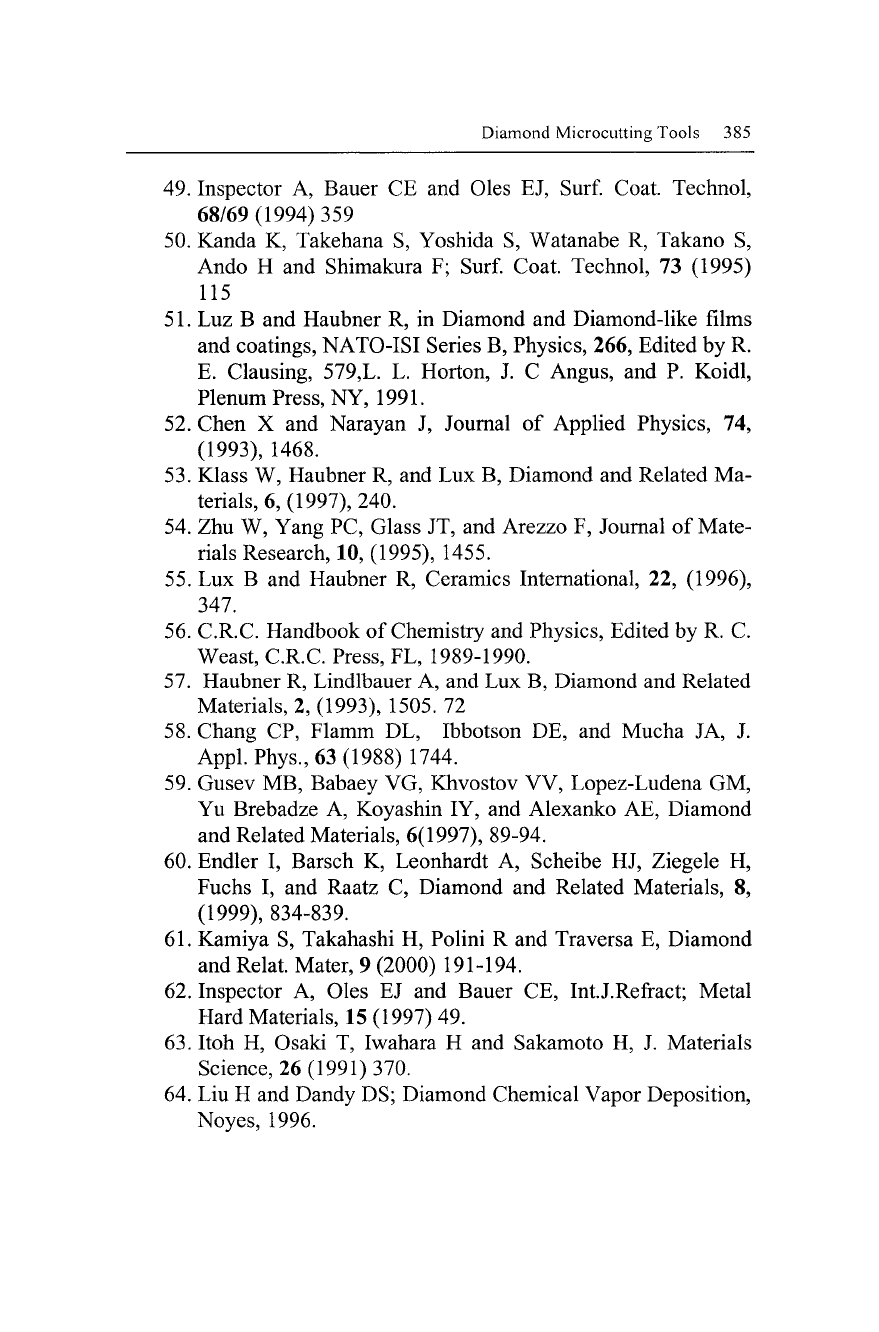
Diamond Microcutting Tools
385
49.
Inspector
A,
Bauer
CE and
Oles
EJ, Surf.
Coat. Technol,
68/69(1994)359
50.
Kanda
K,
Takehana
S,
Yoshida
S,
Watanabe
R,
Takano
S,
Ando
H and
Shimakura
F; Surf.
Coat. Technol,
73
(1995)
115
51.
Luz B and
Haubner
R, in
Diamond
and
Diamond-like films
and coatings, NATO-ISI Series
B,
Physics,
266,
Edited
by R.
E. Clausing, 579,L.
L.
Horton,
J. C
Angus,
and P.
Koidl,
Plenum Press, NY,
1991.
52.
Chen
X and
Narayan
J,
Journal
of
Applied Physics,
74,
(1993),
1468.
53.
Klass
W,
Haubner
R, and Lux B,
Diamond
and
Related
Ma-
terials,
6,
(1997),
240.
54.
Zhu W,
Yang
PC,
Glass
JT, and
Arezzo
F,
Journal
of
Mate-
rials Research,
10,
(1995),
1455.
55.
Lux B and
Haubner
R,
Ceramics International,
22,
(1996),
347.
56.
C.R.C. Handbook
of
Chemistry
and
Physics, Edited
by R. C.
Weast, C.R.C. Press,
FL,
1989-1990.
57.
Haubner
R,
Lindlbauer
A, and Lux B,
Diamond
and
Related
Materials,
2,
(1993), 1505.
72
58.
Chang
CP,
Flamm
DL,
Ibbotson
DE, and
Mucha
JA, J.
Appl.Phys.,
63
(1988)
1744.
59.
Gusev
MB,
Babaey
VG,
Khvostov
VV,
Lopez-Ludena
GM,
Yu Brebadze
A,
Koyashin
lY, and
Alexanko
AE,
Diamond
and Related Materials, 6(1997), 89-94.
60.
Endler
I,
Barsch
K,
Leonhardt
A,
Scheibe
HJ,
Ziegele
H,
Fuchs
I, and
Raatz
C,
Diamond
and
Related Materials,
8,
(1999),
834-839.
61.
Kamiya
S,
Takahashi
H,
Polini
R and
Traversa
E,
Diamond
and Relat. Mater,
9
(2000) 191-194.
62.
Inspector
A,
Oles
EJ and
Bauer
CE,
Int.J.Refract; Metal
Hard Materials,
15
(1997)
49.
63.
Itoh
H,
Osaki
T,
Iwahara
H and
Sakamoto
H, J.
Materials
Science,
26
(1991)
370.
64.
Liu H and
Dandy DS; Diamond Chemical Vapor Deposition,
Noyes,
1996.
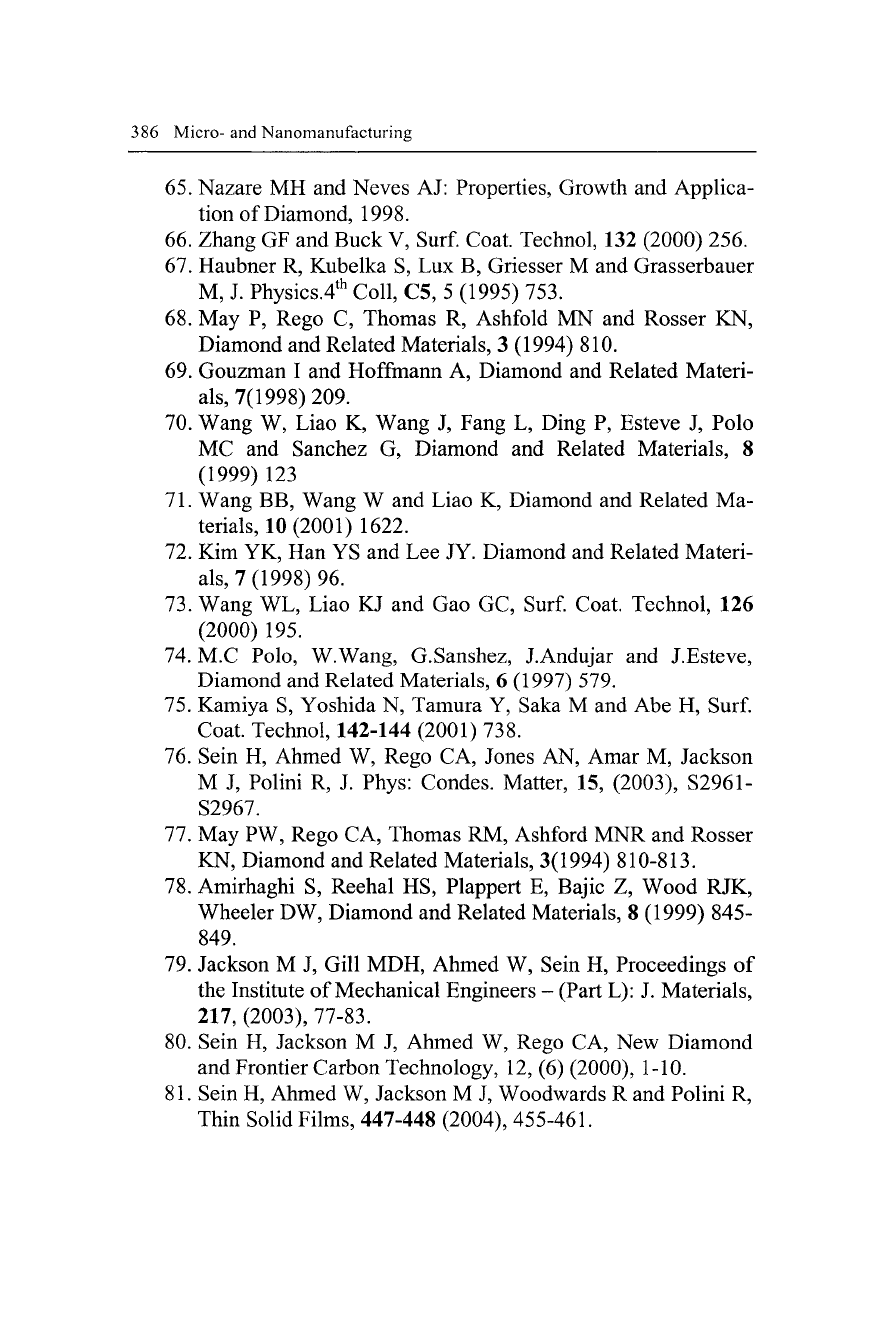
386 Micro-
and
Nanomanufacturing
65.
Nazare
MH and
Neves
AJ:
Properties, Growth
and
Applica-
tion
of
Diamond,
1998.
66.
Zhang
GF and
Buck V,
Surf.
Coat. Technol,
132
(2000)
256.
67.
Haubner
R,
Kubelka
S, Lux B,
Griesser
M and
Grasserbauer
M,
J.
Physics.4* Coll,
C5, 5
(1995)
753.
68.
May P,
Rego
C,
Thomas
R,
Ashfold
MN and
Rosser
KN,
Diamond
and
Related Materials,
3
(1994)
810.
69.
Gouzman
I and
Hoffmann
A,
Diamond
and
Related Materi-
als,
7(1998)
209.
70.
Wang
W,
Liao
K,
Wang
J,
Fang
L,
Ding
P,
Esteve
J,
Polo
MC
and
Sanchez
G,
Diamond
and
Related Materials,
8
(1999)123
71.
Wang
BB,
Wang
W and
Liao
K,
Diamond
and
Related
Ma-
terials,
10
(2001)
1622.
72.
Kim YK, Han YS and Lee JY.
Diamond
and
Related Materi-
als,
7
(1998)
96.
73.
Wang
WL,
Liao
KJ and Gao GC, Surf.
Coat. Technol,
126
(2000)
195.
74.
M.C
Polo, W.Wang, G.Sanshez, J.Andujar
and
J.Esteve,
Diamond
and
Related Materials,
6
(1997)
579.
75.
Kamiya
S,
Yoshida
N,
Tamura
Y,
Saka
M and Abe H, Surf.
Coat. Technol, 142-144 (2001)
738.
76.
Sein
H,
Ahmed
W,
Rego
CA,
Jones
AN,
Amar
M,
Jackson
M
J,
Polini
R, J.
Phys: Condes. Matter,
15,
(2003),
S2961-
S2967.
77.
May PW,
Rego
CA,
Thomas
RM,
Ashford
MNR and
Rosser
KN, Diamond
and
Related Materials, 3(1994) 810-813.
78.
Amirhaghi
S,
Reehal
HS,
Plappert
E,
Bajic
Z,
Wood
RJK,
Wheeler DW, Diamond
and
Related Materials,
8
(1999)
845-
849.
79.
Jackson
M J,
Gill
MDH,
Ahmed
W,
Sein
H,
Proceedings
of
the Institute
of
Mechanical Engineers
-
(Part L):
J.
Materials,
217,
(2003),
77-83.
80.
Sein
H,
Jackson
M J,
Ahmed
W,
Rego
CA, New
Diamond
and Frontier Carbon Technology, 12,
(6)
(2000),
1-10.
81.
Sein
H,
Ahmed
W,
Jackson
M J,
Woodwards
R and
Polini
R,
Thin Solid Films, 447-448 (2004),
455-461.
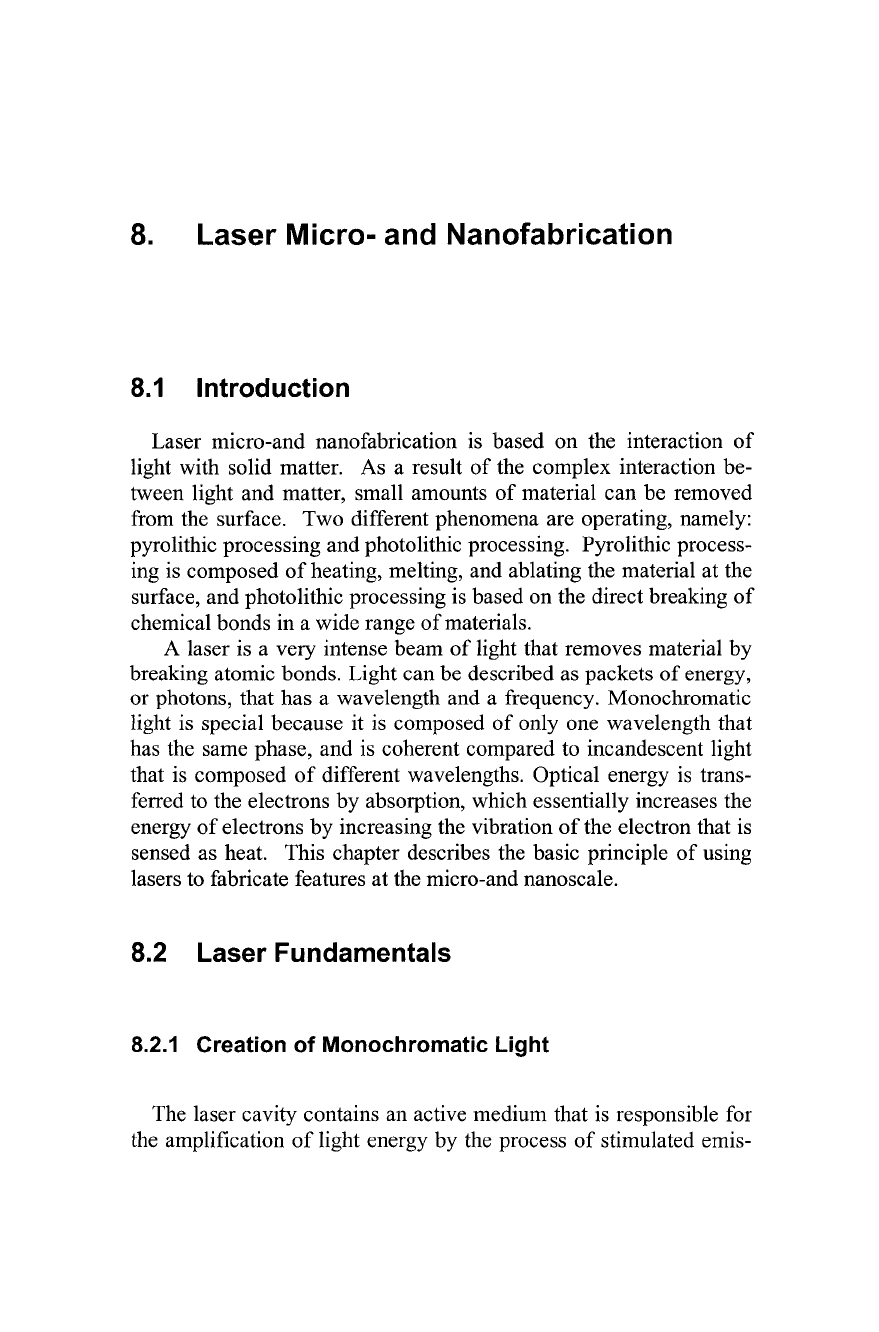
8. Laser Micro- and Nanofabrication
8.1 Introduction
Laser micro-and nanofabrication is based on the interaction of
light with solid matter. As a result of the complex interaction be-
tween light and matter, small amounts of material can be removed
from the surface. Two different phenomena are operating, namely:
pyrolithic processing and photolithic processing. Pyrolithic process-
ing is composed of heating, melting, and ablating the material at the
surface, and photolithic processing is based on the direct breaking of
chemical bonds in a wide range of materials.
A laser is a very intense beam of light that removes material by
breaking atomic bonds. Light can be described as packets of energy,
or photons, that has a wavelength and a frequency. Monochromatic
light is special because it is composed of only one wavelength that
has the same phase, and is coherent compared to incandescent light
that is composed of different wavelengths. Optical energy is trans-
ferred to the electrons by absorption, which essentially increases the
energy of electrons by increasing the vibration of the electron that is
sensed as heat. This chapter describes the basic principle of using
lasers to fabricate features at the micro-and nanoscale.
8.2 Laser Fundamentals
8.2.1 Creation of Monochromatic Light
The laser cavity contains an active medium that is responsible for
the amphfication of light energy by the process of stimulated emis-
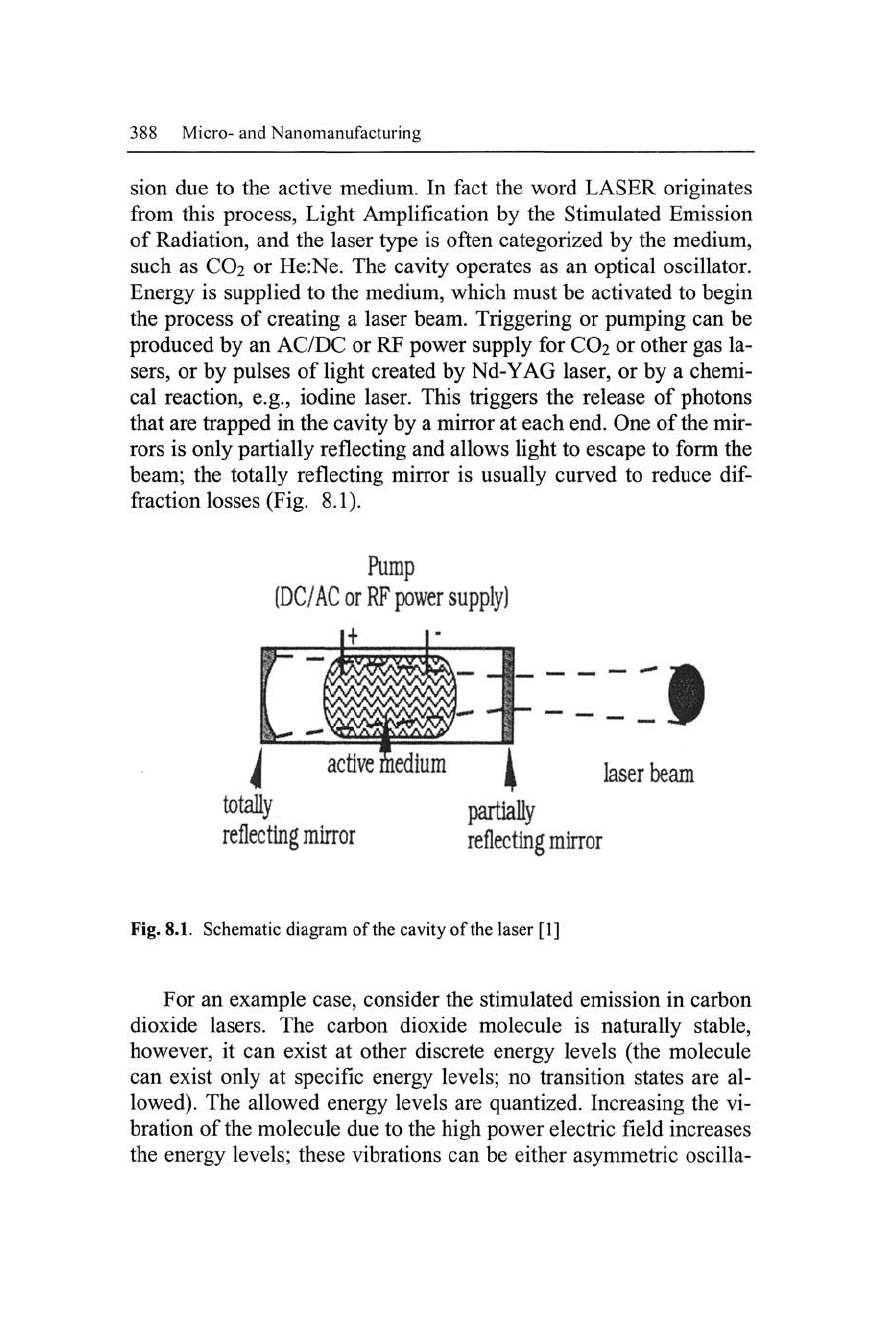
388 Micro-and Nanomanufacturing
sion due to the active medium. In fact the word LASER originates
from this process, Light AmpHfication by the Stimulated Emission
of Radiation, and the laser type is often categorized by the medium,
such as CO2 or He:Ne. The cavity operates as an optical oscillator.
Energy is supplied to the medium, which must be activated to begin
the process of creating a laser beam. Triggering or pumping can be
produced by an AC/DC or RF power supply for CO2 or other gas la-
sers,
or by pulses of light created by Nd-YAG laser, or by a chemi-
cal reaction, e.g., iodine laser. This triggers the release of photons
that are trapped in the cavity by a mirror at each end. One of the mir-
rors is only partially reflecting and allows light to escape to form the
beam; the totally reflecting mirror is usually curved to reduce
dif-
fraction losses (Fig. 8.1).
Pump
(DC/AC or
RF
power supply)
1+
r
r + - - - -
i
laser beam
totally
reflecting mirror
partially
reflecting mirror
Fig. 8.1. Schematic diagram of the cavity of the laser [1]
For an example case, consider the stimulated emission in carbon
dioxide lasers. The carbon dioxide molecule is naturally stable,
however, it can exist at other discrete energy levels (the molecule
can exist only at specific energy levels; no transition states are al-
lowed). The allowed energy levels are quantized. Increasing the vi-
bration of the molecule due to the high power electric field increases
the energy levels; these vibrations can be either asymmetric oscilla-
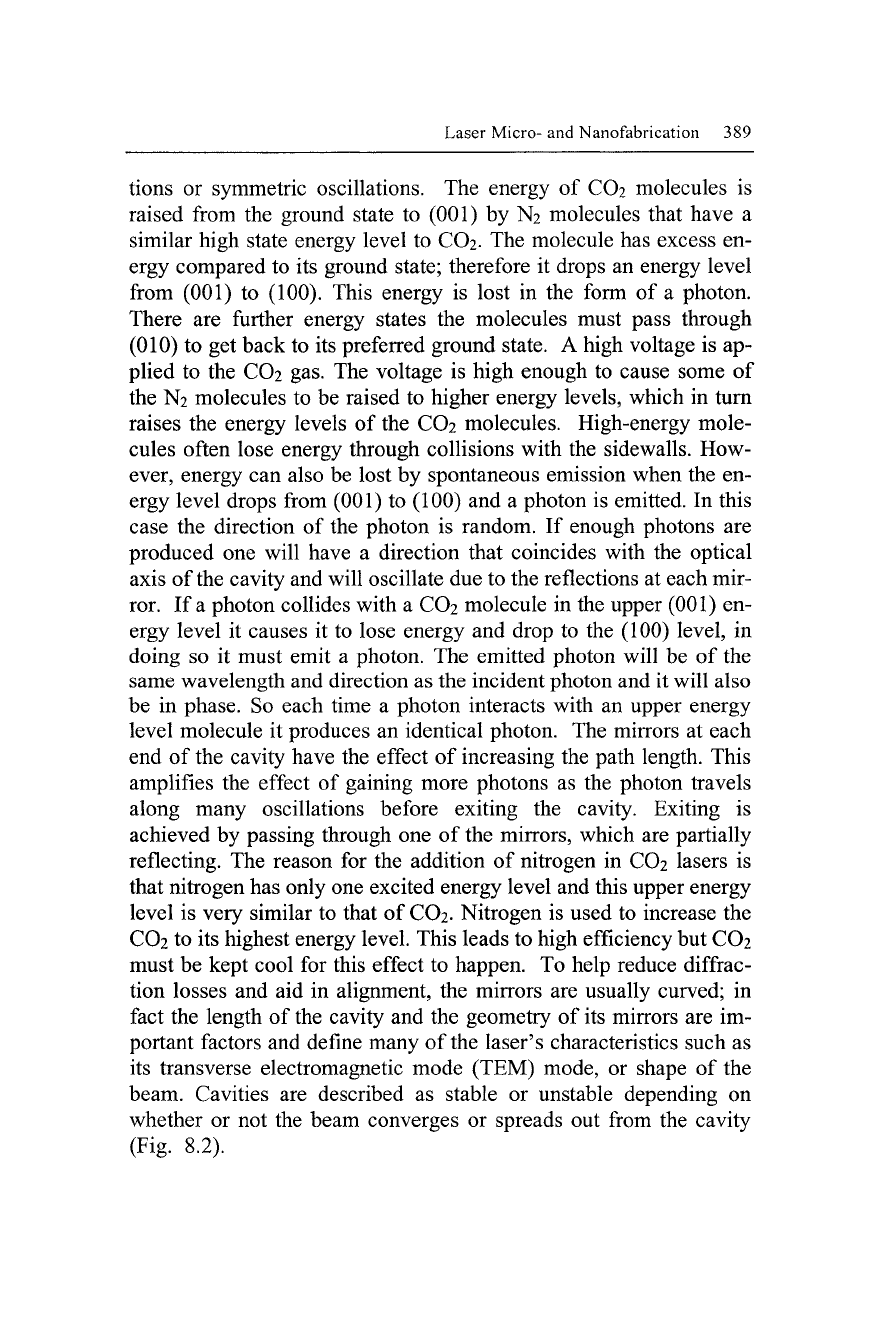
Laser Micro- and Nanofabrication 389
tions or symmetric oscillations. The energy of CO2 molecules is
raised from the ground state to (001) by N2 molecules that have a
similar high state energy level to CO2. The molecule has excess en-
ergy compared to its ground state; therefore it drops an energy level
from (001) to (100). This energy is lost in the form of a photon.
There are further energy states the molecules must pass through
(010) to get back to its preferred ground state. A high voltage is ap-
plied to the CO2 gas. The voltage is high enough to cause some of
the N2 molecules to be raised to higher energy levels, which in turn
raises the energy levels of the CO2 molecules. High-energy mole-
cules often lose energy through collisions with the sidewalls. How-
ever, energy can also be lost by spontaneous emission when the en-
ergy level drops from (001) to (100) and a photon is emitted. In this
case the direction of the photon is random. If enough photons are
produced one will have a direction that coincides with the optical
axis of the cavity and will oscillate due to the reflections at each mir-
ror. If a photon collides with a CO2 molecule in the upper (001) en-
ergy level it causes it to lose energy and drop to the (100) level, in
doing so it must emit a photon. The emitted photon will be of the
same wavelength and direction as the incident photon and it will also
be in phase. So each time a photon interacts with an upper energy
level molecule it produces an identical photon. The mirrors at each
end of the cavity have the effect of increasing the path length. This
amplifies the effect of gaining more photons as the photon travels
along many oscillations before exiting the cavity. Exiting is
achieved by passing through one of the mirrors, which are partially
reflecting. The reason for the addition of nitrogen in CO2 lasers is
that nitrogen has only one excited energy level and this upper energy
level is very similar to that of
CO2.
Nitrogen is used to increase the
CO2 to its highest energy level. This leads to high efficiency but CO2
must be kept cool for this effect to happen. To help reduce diffrac-
tion losses and aid in alignment, the mirrors are usually curved; in
fact the length of the cavity and the geometry of its mirrors are im-
portant factors and define many of the laser's characteristics such as
its transverse electromagnetic mode (TEM) mode, or shape of the
beam. Cavities are described as stable or unstable depending on
whether or not the beam converges or spreads out from the cavity
(Fig. 8.2).
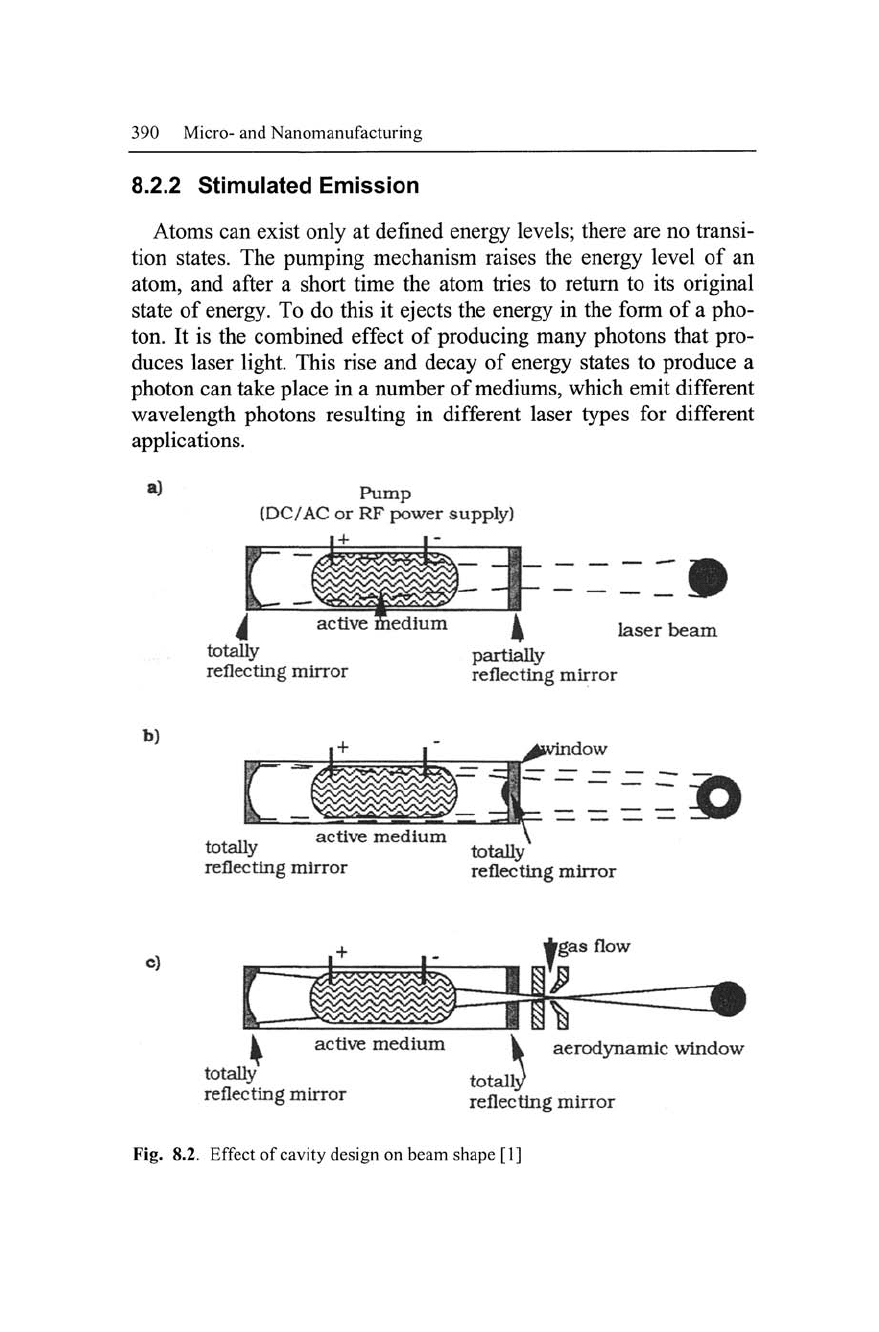
390 Micro- and Nanomanufacturing
8.2.2 Stimulated Emission
Atoms can exist only at defined energy levels; there are no transi-
tion states. The pumping mechanism raises the energy level of an
atom, and after a short time the atom tries to return to its original
state of energy. To do this it ejects the energy in the form of a pho-
ton. It is the combined effect of producing many photons that pro-
duces laser light. This rise and decay of energy states to produce a
photon can take place in a number of mediums, which emit different
wavelength photons resulting in different laser types for different
applications.
Pump
(DC/AC or RF power supply)
i
totaUy
reflecting mirror
laser beam
partially
reflecting mirror
b)
^jvindow
t>
totaUy
reflecting mirror
active medium
totally
reflecting mirror
c)
totaUy
reflecting mirror
gas flow
aerodynamic window
totally
reflecting mirror
Fig. 8.2. Effect of cavity design on beam shape [1]
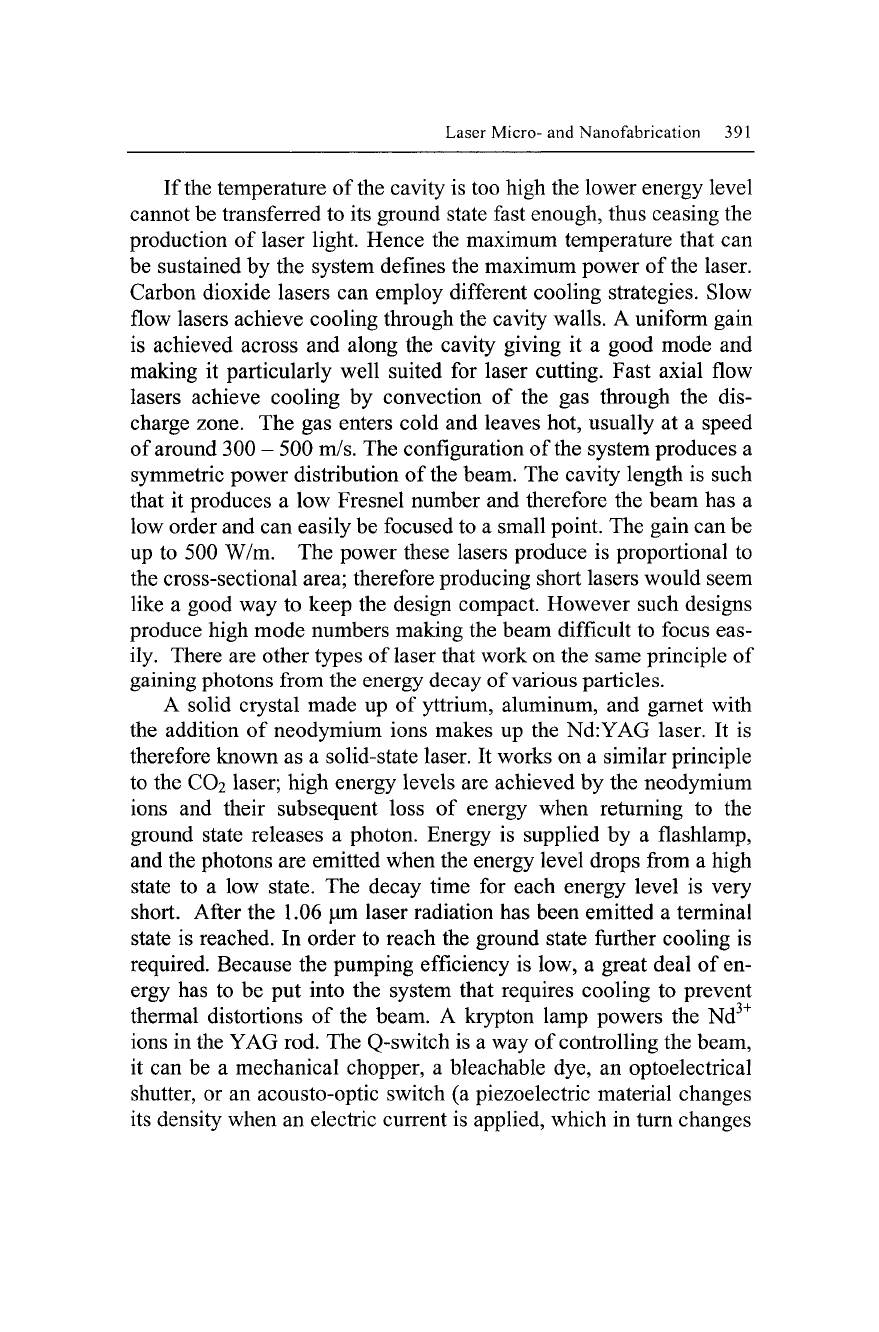
Laser Micro- and Nanofabrication 391
If the temperature of the cavity is too high the lower energy level
cannot be transferred to its ground state fast enough, thus ceasing the
production of laser light. Hence the maximum temperature that can
be sustained by the system defines the maximum power of the laser.
Carbon dioxide lasers can employ different cooling strategies. Slow
flow lasers achieve cooling through the cavity walls. A uniform gain
is achieved across and along the cavity giving it a good mode and
making it particularly well suited for laser cutting. Fast axial flow
lasers achieve cooling by convection of the gas through the dis-
charge zone. The gas enters cold and leaves hot, usually at a speed
of around 300 - 500 m/s. The configuration of the system produces a
symmetric power distribution of the beam. The cavity length is such
that it produces a low Fresnel number and therefore the beam has a
low order and can easily be focused to a small point. The gain can be
up to 500 W/m. The power these lasers produce is proportional to
the cross-sectional area; therefore producing short lasers would seem
like a good way to keep the design compact. However such designs
produce high mode numbers making the beam difficult to focus eas-
ily. There are other types of laser that work on the same principle of
gaining photons from the energy decay of various particles.
A solid crystal made up of yttrium, aluminum, and garnet with
the addition of neodymium ions makes up the Nd:YAG laser. It is
therefore known as a solid-state laser. It works on a similar principle
to the CO2 laser; high energy levels are achieved by the neodymium
ions and their subsequent loss of energy when returning to the
ground state releases a photon. Energy is supplied by a flashlamp,
and the photons are emitted when the energy level drops from a high
state to a low state. The decay time for each energy level is very
short. After the 1.06 |Lim laser radiation has been emitted a terminal
state is reached. In order to reach the ground state further cooling is
required. Because the pumping efficiency is low, a great deal of en-
ergy has to be put into the system that requires cooling to prevent
thermal distortions of the beam. A krypton lamp powers the Nd^^
ions in the YAG rod. The Q-switch is a way of controlling the beam,
it can be a mechanical chopper, a bleachable dye, an optoelectrical
shutter, or an acousto-optic switch (a piezoelectric material changes
its density when an electric current is applied, which in turn changes
